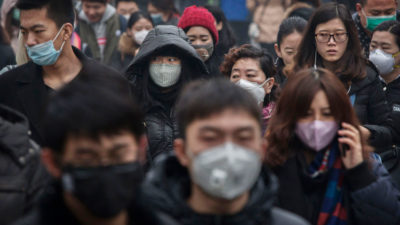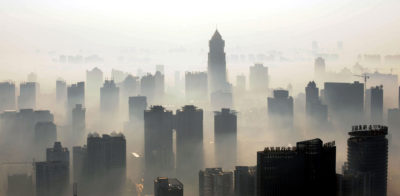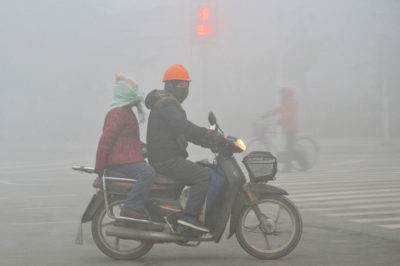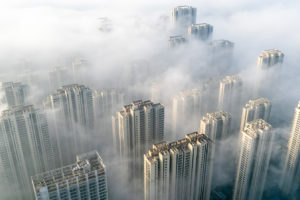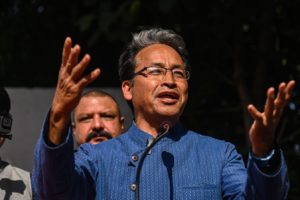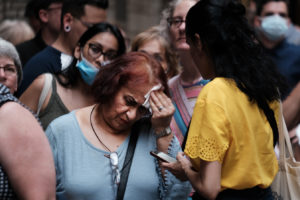The hazes can be choking and can reduce visibility at noon to a few tens of yards. Fumes belch from factory chimneys, coal-fired power plants, heating systems in apartment blocks, and millions of road vehicles. When the weather traps smog in the streets, city hospital admissions soar and the morgues fill.
The foul air of dozens of fast-expanding cities across China contains cocktails of toxic contaminants unprecedented in the range of pollutants they contain at high concentrations. Now, new research into these swirling maelstroms of gases and tiny particulates suggests that they may be incubating chemical reactions that compound the health effects in ways not seen before – effects that doctors say are cutting five years off the expected lifespan of half a billion people in northern China.
A study by Chinese and U.S. researchers, published in the bulletin of the World Health Organization (WHO) in February, says the science and regulation of smogs have not kept up with their changing composition in the 21st century. In particular, they do not track the “multi-contaminant” nature of the new smogs. Lijian Han and colleagues from the Chinese Academy of Sciences’ Research Center for Eco-Environmental Sciences in Beijing, who were among the study’s coauthors, are calling for a new approach to assessing the health risks from chemically complex urban smogs – not just in China, but across the fast-industrializing and urbanizing countries of the developing world.
The unprecedented speed of industrialization and urbanization has combined two eras of pollution.
Most monitoring of urban air still concentrates on one or at most two pollutants, sometimes particulates, sometimes nitrogen oxides or sulphur dioxides or ozone. Similarly, most medical studies of the impacts of these toxins look for links between single pollutants and suspected health effects such as respiratory disease and cardiovascular conditions. And most air quality standards – drawn up by the WHO, the U.S. Environmental Protection Agency, Chinese authorities, and others – are still based on limits to the same individual pollutants.
But real air pollution is not so simple. The new study argues that smogs in China contain more ingredients than those found either in the legendary “pea-soupers” of 19th- and 20th-century Europe and North America or in modern rich-world, vehicle-generated smogs. Something new is happening: The unprecedented speed of industrialization and urbanization has combined two eras of pollution.
In Europe and North America, there have effectively been two eras of smogs, with different chemistries. The first was characterized by heavy particulates and sulphur dioxide from burning coal in cities. It was in decline before the peak of the second phase, which arose from nitrogen oxides, fine particulates emitted by automobiles, and other compounds often combining photochemically in summer sunlight to create ozone.
But in China, India, and other developing countries today, the two eras have come together. According to Han and his colleagues, “The development of coal-fired industries and increased automobile use have overlapped, which has resulted in the emissions of a complex mix of air contaminants.”
Wuhan, seen here covered in smog in 2009, is one of the Chinese cities found to regularly have dangerous levels of multiple air contaminants. STR/AFP/Getty Images
Such mixes have so far largely evaded the attention of air pollution researchers, toxicologists, epidemiologists, and regulators, says the American coauthor of the study, Steward Pickett of the Cary Institute of Ecosystem Studies in Millbrook, New York. “The vast majority of research focuses on single contaminants. That is obviously not how pollution actually exists in the atmosphere,” he says.
The mismatch appears to have caused researchers to miss the potentially deadly consequences. “The chemistry of China’s polluted urban air is unprecedented,” Markku Kulmala, an atmospheric modeler at the University of Helsinki, wrote in the science journal Nature two years ago. “We do not know and cannot predict which harmful compounds are being formed.”
China has the world’s most dangerous outdoor air pollution. The country emits about a third of all the human-made sulphur dioxide (SO2), nitrogen oxides (NOx), and particulates that are poured into the air around the world. The Global Burden of Disease Study, an international collaboration, estimates that 1.1 million Chinese die from the effects of this air pollution each year, roughly a third of the global death toll.
Smogs are generally worst in the cities of northern China, especially in winter when industrial emissions and traffic fumes are compounded by heavy coal burned to heat homes and offices. A 2013 estimate by economist Michael Greenstone, then at MIT, and colleagues put the impact on life expectancy at a staggering five years for 500 million Chinese citizens living north of the Huai river, which divides the north and south of the country.
Han and colleagues studied official air pollution data from 155 Chinese cities. They looked at data for SO2, NOx, ozone, particulates less than 10 microns in diameter (known as PM10), and finer particulates less than 2.5 microns across (PM2.5), which can penetrate deepest into lungs and even cross into the blood system.
Instead of looking at single pollutants, as the regulatory authorities do, they examined the combinations. They found that dozens of Chinese cities regularly exceeded WHO health limits for several pollutants at once and that the cities that suffered most from this “multi-contamination” were often not the largest cities, nor those with the highest levels for individual pollutants.
The largest Chinese cities have implemented environmental protections, leading polluting industries to relocate to smaller cities.
“In general,” the authors say, “multi-contaminant air pollution was less frequent in cities with populations over 10 million than in smaller cities.” China has 15 megacities with a population of over 10 million, but pollution was worst in cities with populations between 500,000 and 10 million. The reason, they suggest, is that the largest cities have implemented “extensive environmental protection measures,” leading many polluting industries to relocate to smaller cities.
Unlike megacities such as Beijing, Tianjin, or Shanghai, these hidden hotspots have rarely grabbed the headlines and have not attracted the attention of state pollution controllers. The paper names four cities that suffered smogs in which all five of the contaminants were above WHO guidelines for more than eight days a year – Dongying, Linya, Weifang, and Zibo. All are in Shandong, an industrial province in northeast China. They have populations of between 1 and 3.5 million; none is among China’s 30 largest cities.
Three other cities listed as regularly suffering dangerous levels of four or five of the pollutants are Jining, also in Shandong, Wuhan in Hubei province, and Jiayuguan and Jinchang in Gansu. None of the seven appear in the lists of the ten most polluted Chinese cities published by the WHO or Chinese environment ministry.
How hazardous are these hidden cocktails of pollution?
All the five major pollutants in smogs – SO2, NOx, ozone, PM10 and PM2.5 — are known to be linked individually to increased risk of strokes, heart disease, lung cancer and asthma, and to rising hospital admissions and death rates during smogs. What is disturbing is that there is growing evidence of synergistic effects between these different pollutants that make the whole worse than the sum of the parts. “The disease burden will be underestimated” by conventional measures, say the authors of the study in the WHO bulletin.
The extent of this underestimation is presently unknown. Studies into the health effects of a single pollutant breathed in over many decades are hard enough, without trying to gauge the effect of several at the same time and in different combinations. Results “become highly unstable when incorporating two or more pollutants that are highly correlated,” according to a 2010 paper by Francesca Dominici of Harvard’s School of Public Health and colleagues.
Researchers point out that attempts to control one air pollutant can increase the concentration of others.
In the past year, her research team has published two studies showing clear effects from ozone and PM2.5 at or below the WHO-recommended limits. Such findings raise the stakes for the harm likely to be done by the pollution cocktails in China and elsewhere.
Kulmala, in his Nature article titled “China’s choking cocktail,” says we can expect “chains of chemical reactions” taking place among the multiple pollutants on Chinese smogs. Those reactions, he says, may have unexpected consequences that make conventional regulation of individual pollutants unpredictable and even counterproductive.
“Attempts to control one pollutant can increase the concentration of others,” he warned. For instance, controlling NOx emissions can sometimes result in a tenfold increase in ozone levels in summer, because while some NOx compounds create ozone, others destroy it.
Once pollutants are inhaled, there may be unexpected synergistic health effects, too, according to Joe Mauderly of the Lovelace Respiratory Research Institute in Albuquerque, New Mexico. The synergies may either accelerate or decelerate dangerous biochemical changes.
Researchers in the megacity of Guangzhou in southern China recently published data showing an apparent synergistic effect in the city between nitrogen dioxide (one type of NOx emission) from vehicles emissions and PM10 particulates from coal burning. When either of the pollutants were at high levels, there were more deaths in the city over the subsequent two days, especially cardiovascular deaths. But, most disturbingly, when both pollutants were at high levels, the increased death toll was more than twice as high as for one pollutant. In combination, they “mutually amplify the risk of mortality,” concluded the paper’s lead author, Yuzhou Gu of the Guangzhou Center for Disease Control and Prevention.
Cyclists ride through a heavy smog in the city of Weifang, in China's Shandong province, in January 2017. Imaginechina via AP Images
A large study of air pollution and health published in 2008 found the same thing in Europe, with extra nitrogen dioxide apparently exacerbating the death toll from PM10.
Uta Wille at the University of Melbourne, Australia, offers one clue as to why such synergies might occur. She reported that both nitrogen dioxide and ozone reduce the body’s defenses against environmental oxidants, which damage body tissues including the lungs. Since both ozone and nitrogen dioxide are themselves environmental oxidants, Wille and fellow researchers concluded, the damage caused by the presence of both was greater than the sum of the damage caused by the presence of each pollutant individually.
China is trying to clean up its air. The authorities faced a tide of public anger and international criticism after intense smogs in the winter of 2013, when particulate levels in Beijing were 40 times WHO-recommended levels. The central government set targets for reducing PM2.5 concentrations.
To meet them, 28 big northern cities moved to banish polluting industries such as cement and steel works and replace coal with natural gas for domestic heating. They have had some success. The Ministry of Environmental Protection announced in early 2018 that all 28 cities had met their new PM2.5 targets. When Beijing largely escaped serious smogs this past winter, officials heralded a “new reality” for a “population who were used to wearing masks and turning on air purifiers.”
The official data were confirmed by informal sources such as measurements made on the roof of the U.S. embassy in Beijing, though Greenpeace claimed that at least part of last winter’s improvement in the capital’s air was due to favorable weather conditions, with cold fronts from Siberia bringing regular infusions of fresh air.
But the evidence of Han’s study is that reducing one pollutant in a handful of large cities is unlikely to improve things in dozens of other smaller cities where pollution cocktails persist and grow. In fact, if regulators merely force the most polluting industries to move from large cities to smaller ones, it could make things worse.
